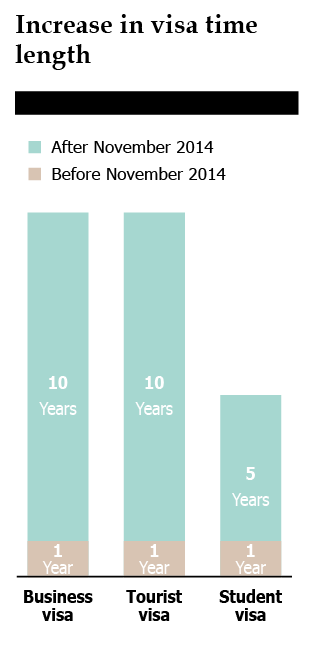By Elizabeth Barrett
The “APEC Blue” skies of last November have come and gone, but the progress made on visa reforms during the Asia-Pacific Economic Cooperation meetings will have a strong and lasting impact on both countries economically and culturally.
Starting last November, Chinese and Americans have been able to apply for longer visas. Tourist, business and student visas no longer max out at one year. Now, tourist and business visas can be valid for 10 years, and student visas for five years. The specifics remain unclear about the legal length of stay or number of visits within that 10-year period. However, the key point is that both China and the US are encouraging visitors from the other country with the hope of boosting business and the economy. With this reform, the visa process becomes less of a burden on Chinese and Americans wanting to travel and study in each other’s country. A press release from the White House stated the benefits of “increasing opportunities for people-to-people ties, and boosting mutual understanding.”
Besides increasing the potential for cultural and educational exchanges, the visa extension will also benefit the hospitality and tourism industries. The US Department of Trade reported in 2013 that visitors from China increased 464 percent between 2006 and 2013. The amount of money Chinese spent on travel and tourism alone during this period was over $17 billion. Even before the visa reforms went into effect, Chinese nationals were visiting the US in record numbers. The Department of Commerce reported in April 2014 that general tourism to the US is expected to grow, with China supplying the biggest increase of tourists (139 percent) between 2013 and 2018.
US Secretary of Commerce Penny Pritzker recognized how the US stands to benefit from this new openness.
“With the help of this [visa] change, up to 7.3 million Chinese visitors – more than any other country except Canada and Mexico – are projected to visit the United States in 2021,” Pritzker said. These visitors contribute about $85 billion a year to the US economy, and support 440,000 American jobs. “That is four times as many travelers supporting four times as many American jobs as compared to last year.”
Of course, it isn’t just tourist and business visas that Chinese are interested in. For the second year in a row, the quota for EB-5 visas, which grants a Green Card to those who invest in the US, has been reached well before the end of the year. There are now special limitations on applications from Chinese, who make up about 90 percent of the applications. Even so, the US offers just 10,000 EB-5 visas each year, so the bulk of Chinese visitors will be travelling on other kinds of visa.
The US Office of Travel and Tourism Industries, part of the Department of Commerce, reported that in 2014, over 2 million Chinese nationals arrived in the US from China (not including Hong Kong) for non-residential purposes. That number is only expected to rise with the new prospect of being able to visit the US more often on the same visa.
Chinese travelers cite ease of visa policies as the second most important factor in deciding where to travel, behind only cost, according to a White House fact sheet.
Chinese travelers persistently name the US as their top dream travel destination, but so far it's been an often unrealized dream. Only about 1.8 percent of total outbound travelers from China go to the US.
“A competitive visa policy is needed to secure our place as the chosen destination for millions of Chinese travelers,” the White House said in a press release.
The continued growing affluence of the Chinese middle class coupled with the more favorable visa process should move this percentage up significantly. Since 2008, Chinese tourism to the US has accounted for a large percentage of travel when compared to other nationals visiting the US. The White House predicts Chinese travel to the US will grow from 2.1 million in 2014 to 7.3 million by 2021.
What the US can expect in the short-term is an influx of Chinese tourists and students, which will give companies, particularly those in the tourism and hospitality industries, an economic boost. According to an industry snapshot from SelectUSA, “One out of every 17 Americans works, either directly or indirectly, in a travel or tourism-related industry.” The increase in Chinese tourism to the US will only increase this ratio as well as the investment by US tourism agencies and national sites to target and market to Chinese visitors.
Elizabeth Barrett is the Staff Coordinator of the AmCham China Visa Committee.

